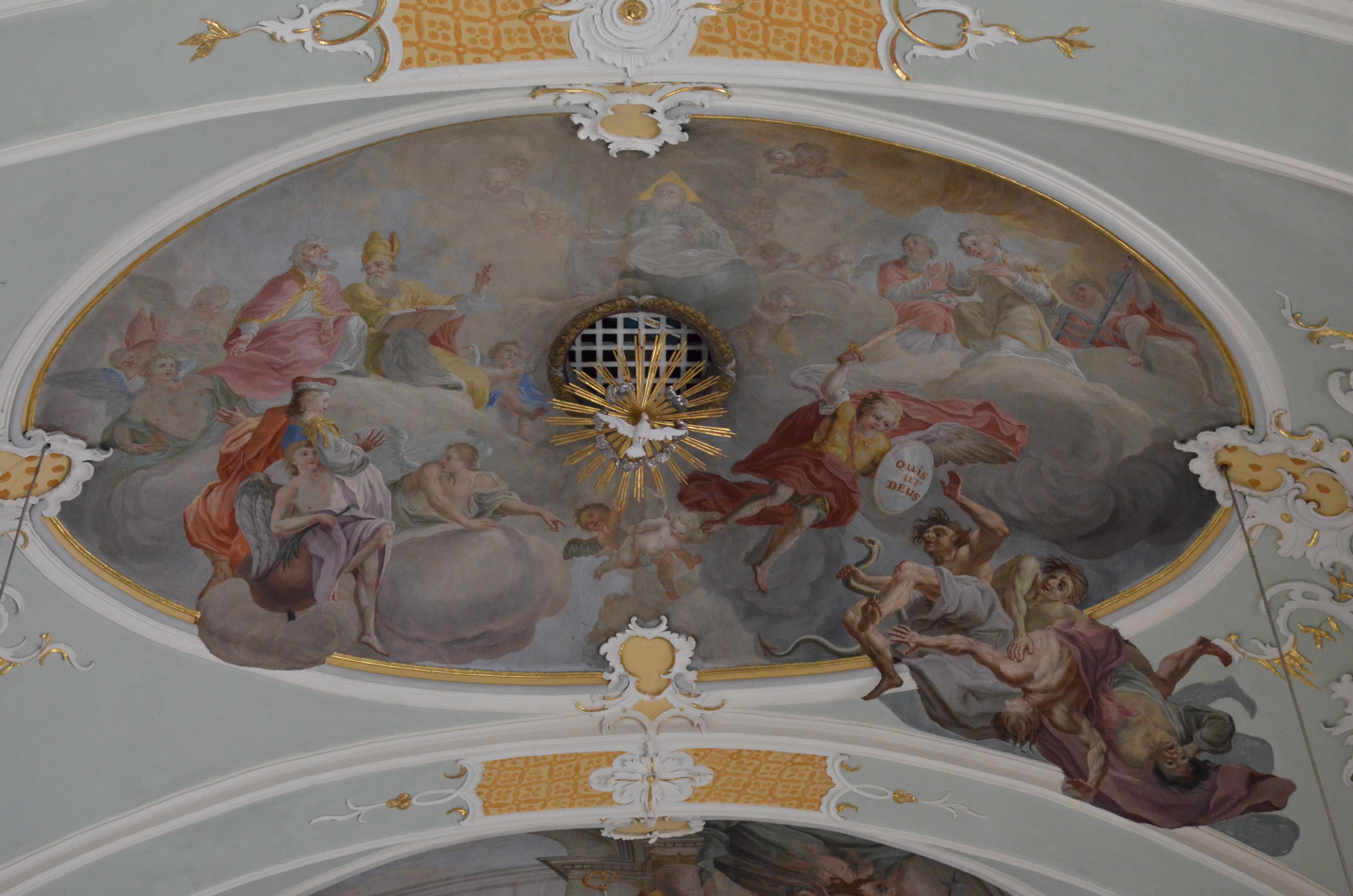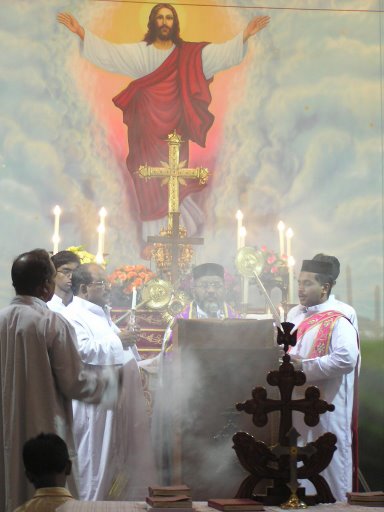|
Holy Ghost Hole
A Holy Ghost hole, or Holy Spirit hole, is a circular opening in the ceiling of a church which symbolises the descent of the Holy Spirit on the day of Pentecost. The openings are often used for liturgical performances. They were most commonly built in churches in Austria and southern Germany during the Middle Ages and Baroque period, though classicizing architectural elements often replicate their appearance. Baroque organ sound-holes, in particular, were often decorated or disguised as Holy Ghost holes. Other features of church architecture which are similarly built into the apex of a ceiling or dome, such as oculi, often closely resemble Holy Ghost holes. Decoration Holy Ghost holes are typically decorated with Pentecostal motifs, such as doves, rays of light, and flames. The hole may be permanently left open, displaying a dove figurine or other depictions of the holy spirit. However, the holes are often covered by latticework or a wooden lid which is only opened during litur ... [...More Info...] [...Related Items...] OR: [Wikipedia] [Google] [Baidu] |
Oakum
Oakum is a preparation of tarred fibre used to seal gaps. Its main traditional applications were in shipbuilding, for caulking or packing the joints of timbers in wooden vessels and the deck planking of iron and steel ships; in plumbing, for sealing joints in cast iron pipe; and in log cabins for chinking. In ship caulking, it was forced into the seams using a hammer and a caulking iron, then sealed into place with hot pitch. It is also referenced frequently as a medical supply for medieval surgeons, often used along with bandages for sealing wounds. History The word oakum derives from Middle English ', from Old English ', from ' ( separative and perfective prefix) + ' (akin to Old English ', 'comb')—literally 'off-combings'. Oakum was at one time recycled from old tarry ropes and cordage, which were painstakingly unravelled and reduced to fibre, termed "picking". The task of picking and preparation was a common occupation in prisons and workhouses, where the young or th ... [...More Info...] [...Related Items...] OR: [Wikipedia] [Google] [Baidu] |
Rehling
Rehling is a municipality in the district of Aichach-Friedberg in Bavaria in Germany Germany,, officially the Federal Republic of Germany, is a country in Central Europe. It is the second most populous country in Europe after Russia, and the most populous member state of the European Union. Germany is situated betwee .... References Aichach-Friedberg {{AichachFriedberg-geo-stub ... [...More Info...] [...Related Items...] OR: [Wikipedia] [Google] [Baidu] |
Ebbs
Ebbs is a municipality in the Kufstein district of Tyrol in Austria. The village is located in the Judicial district of Kufstein and in 2016 had a population of 5,480. Geography Ebbs is located in the Lower Inn Valley near Kufstein, to the east of the Inn river at the foot of the Kaiser Mountains. Ebbs is ranked among the largest municipalities in the Kufstein district and one of the largest villages in Tyrol. At 475 m above sea level, it is also the lowest village in Tyrol. The Inn forms the border to Bavaria Bavaria ( ; ), officially the Free State of Bavaria (german: Freistaat Bayern, link=no ), is a state in the south-east of Germany. With an area of , Bavaria is the largest German state by land area, comprising roughly a fifth of the total lan .... References External links Official website Cities and towns in Kufstein District {{Tyrol-geo-stub ... [...More Info...] [...Related Items...] OR: [Wikipedia] [Google] [Baidu] |
Church Of The Holy Spirit, Heidelberg
The Church of the Holy Spirit (german: Heiliggeistkirche) is the largest church in Heidelberg, Germany. The church, located in the marketplace in the old town center, was constructed between 1398 and 1515 in the Romanesque and Gothic styles. It receives 1–3 million guests annually, making it among the most visited churches in Germany. The church was planned as the burial place of the Electors of the Palatinate and as a representative church of the Palatinate royal seat. In the Palatine War of Succession, the princely graves of the Electors were destroyed; today only the grave of the founder of the church, Elector Ruprecht III, remains. The church was also the location of the founding of the Heidelberg University and was the original repository of the Bibliotheca Palatina. The congregation was originally Roman Catholic, but the church has changed denominations more than ten times through its history. Intermittently, over a 300-year period, the nave and the choir of the church w ... [...More Info...] [...Related Items...] OR: [Wikipedia] [Google] [Baidu] |
Eye Of Providence
The Eye of Providence (or the All-Seeing Eye of God) is a symbol that depicts an eye, often enclosed in a triangle and surrounded by Ray (optics), rays of light or Glory (optical phenomenon), glory, meant to represent divine providence, whereby the eye of God watches over humanity. A well-known example of the Eye of Providence appears on the reverse of the Great Seal of the United States, which is depicted on the United States one-dollar bill. Use by governments and confederations United States In 1782, the Eye of Providence was adopted as part of the Symbolism (arts), symbolism featured on the reverse side of the Great Seal of the United States. It was first proposed as an element of the Great Seal by the first of three design committees in 1776, and is thought to be the suggestion of the artistic consultant, Pierre Eugene du Simitiere,Bureau of Public Affairs. July 2003.The Great Seal of the United States" Washington: United States Department of State, U.S. Department of ... [...More Info...] [...Related Items...] OR: [Wikipedia] [Google] [Baidu] |
Söll
Söll is a municipality in the district of Kufstein in the Austrian region of Sölllandl. It is located 9 km south of Kufstein and 9 km east of Wörgl. The village consists of 25 subdivisions. The main sources of income are agriculture and tourism. Tourist attractions Söll is one of the principal ski-holiday villages of the region ''Ski Welt Wilder Kaiser''. It is located beneath the conical Hohe Salve peak, the highest point in the ski area. The Hohe Salve also offers black and red classified ski runs as well as ski routes from the top lift station. The Hohe Salve has a church located on its peak as well as a mountain restaurant that features a revolving terrace, offering a panoramic view of the region. Further ski holiday resorts in the ''Ski Welt Wilder Kaiser'' region are Itter, Scheffau, Ellmau, Going, Brixen and Hopfgarten. A new lift is scheduled to open for the 2008/09 ski season that will link Brixen to Westendorf and furthermore to Kitzbühel, thus creating ... [...More Info...] [...Related Items...] OR: [Wikipedia] [Google] [Baidu] |
Kurier
''Kurier'' is a German-language daily newspaper based in Vienna, Austria. History and profile ''Kurier'' was founded as ''Wiener Kurier'' by the United States Forces in Austria (USFA) in 1945, during the Allied occupation after World War II. In 1954 the paper was acquired and re-established by Ludwig Polsterer as ''Neuer Kurier'' (New Kurier). Funke Mediengruppe holds 49% of the paper. The company also partly owns ''Kronen Zeitung''. The publisher of ''Kurier'' is Kurier-Zeitungsverlag und Druckerei GmbH. ''Kurier'' is based in Vienna en, Viennese , iso_code = AT-9 , registration_plate = W , postal_code_type = Postal code , postal_code = , timezone = CET , utc_offset = +1 , timezone_DST .... Circulation ''Kurier'' was the eighteenth largest newspaper worldwide with a circulation of 443,000 copies in the late 1980s. It was the third best-selling Austrian newspaper in 1993 with a circ ... [...More Info...] [...Related Items...] OR: [Wikipedia] [Google] [Baidu] |
Münchner Merkur
The ''Münchner Merkur'' (, literally "Munich Mercurius", i.e. the Roman god of messengers) is a German Bavarian daily subscription newspaper, which is published from Monday to Saturday. It is located in Munich and belongs to the Müncher Merkur/tz media group. The paid circulation of the ''Münchner Merkur'' is 271.335 copies. History The ''Merkur'' was the second newspaper after the ''Süddeutsche Zeitung'' which was allowed to be published in Munich. 1968 the subsidiary '' tz'' was brought onto the market as a tabloid. The first edition of what was initially named ''Münchner Mittag'' ("Munich Noon"), was released on 13 November 1946 through a licence of the American military government. One of the founding members and publishers was Felix Buttersack. In 1982, the Westphalia Westphalia (; german: Westfalen ; nds, Westfalen ) is a region of northwestern Germany and one of the three historic parts of the state of North Rhine-Westphalia. It has an area of and 7.9 m ... [...More Info...] [...Related Items...] OR: [Wikipedia] [Google] [Baidu] |
Feast Of The Ascension
The Solemnity of the Ascension of Jesus Christ, also called Ascension Day, Ascension Thursday, or sometimes Holy Thursday, commemorates the Christian belief of the bodily Ascension of Jesus into heaven. It is one of the ecumenical (i.e., shared by multiple denominations) feasts of Christian churches, ranking with the feasts of the Passion and Pentecost. Following the account of that the risen Jesus appeared for 40 days prior to his Ascension, Ascension Day is traditionally celebrated on a Thursday, the fortieth day of Easter; although some Christian denominations have moved the observance to the following Sunday. The day of observance varies by ecclesiastical province in many Christian denominations, as with Methodists and Catholics, for example. History The observance of this feast is of great antiquity. Eusebius seems to hint at the celebration of it in the 4th century. At the beginning of the 5th century, Augustine of Hippo says that it is of Apostolic origin, and he speaks of ... [...More Info...] [...Related Items...] OR: [Wikipedia] [Google] [Baidu] |
Aletia
''Aletia'' is a genus of owlet moth Moths are a paraphyletic group of insects that includes all members of the order Lepidoptera that are not butterflies, with moths making up the vast majority of the order. There are thought to be approximately 160,000 species of moth, many of w ...s of the family Noctuidae described by Jacob Hübner in 1821. New Zealand species In 2019 Robert Hoare undertook a major review of New Zealand Noctuidae. During this review the genus ''Ichneutica'' was greatly expanded and the genus ''Aletia'' was subsumed into that genus as a synonym. Species Some species of this genus are: *'' Aletia amlaki'' (Laporte, 1984) *'' Aletia angustipennis'' (Saalmüller, 1891) *'' Aletia ankaratra'' Rungs, 1956 *'' Aletia circulus'' (Saalmüller, 1880) *'' Aletia consanguis'' (Guenée, 1852) *'' Aletia cuneata'' Philpott, 1916 *'' Aletia decaryi'' (Boursin & Rungs, 1952) *'' Aletia duplex'' Rungs, 1956 *'' Aletia elisa'' (Berio, 1962) *'' Aletia evoei'' (Lapo ... [...More Info...] [...Related Items...] OR: [Wikipedia] [Google] [Baidu] |




